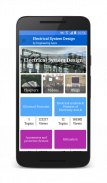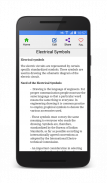










Electrical System Design

وصف لـElectrical System Design
The app is a complete free handbook of Electrical System Design & Estimation, cover important topics, notes, materials, news & blogs on the course. Download the App as a reference material & digital book for control systems, Electrical & computer science engineering programs & degree courses.
This useful App lists 100 topics with detailed notes, diagrams, equations, formulas & course material, the topics are listed in 6 chapters. The app is must have for all the engineering science students & professionals.
The app provides quick revision and reference to the important topics like a detailed flash card notes, it makes it easy & useful for the student or a professional to cover the course syllabus quickly before an exams or interview for jobs.
Track your learning, set reminders, edit the study material, add favorite topics, share the topics on social media.
You can also blog about engineering technology, innovation, engineering startups, college research work, institute updates, Informative links on course materials & education programs from your smartphone or tablet or at http://www.engineeringapps.net/.
Use this useful engineering app as your tutorial, digital book, a reference guide for syllabus, course material, project work, sharing your views on the blog.
Some of the topics Covered in the app are:
1. Types of lighting schemes
2. Electrical Symbols
3. Lists of Electrical symbols
4. Salient Features of Electricity Act, 2003
5. Consequences of Electricity Act, 2003
6. Indian Electricity Rules (1956)
7. General safety precautions
8. Role and Scope of National Electric Code
9. Components of National electric code
10. Classification of Supply Systems - TT system
11. Classification of Supply Systems - TN system
12. Classification of Supply Systems - IT system
13. Selection criteria for the TT, TN and IT systems
14. Load break switches
15. Switch Fuse Units & Fuse Switches
16. Circuit Breakers - MCB
17. Circuit Breakers - MCB Selection & Characteristics
18. Circuit Breakers - RCCB
19. Circuit Breakers - MCCB
20. Circuit Breakers - ELCB
21. Circuit Breakers - Voltage Base ELCB
22. Circuit Breakers - Current-operated ELCB
23. Circuit Breakers - ACB
24. Operation of ACB
25. Air Blast Circuit Breaker
26. Different Types of Air Blast Circuit Breaker
27. Circuit Breakers - OCB
28. Bulk Oil Circuit Breaker
29. Single & Double Break Bulk Oil Circuit Breaker
30. Circuit Breakers - Minimum Oil
31. Circuit breakers - VCB
32. Electrical Switchgear
33. SF6 Circuit Breaker
34. Types and Working of SF6 Circuit Breaker
35. Vacuum Arc or Arc in Vacuum
36. Different types of fuses
37. Protection against over load
38. Delay curves
39. Service connections
40. Electrical Diagrams
41. Methods for representation for wiring diagrams
42. Systems of House Wiring
43. Neutral and earth wire
44. Load Factor for Electrical Installations
45. Earth bus- Design of earthing systems
46. Demand Factor for electrical installations
47. Diversity Factor for electrical installations
48. Utilization factor & Maximum Demand for electrical installations
49. Coincidence factor for electrical installations
50. Demand Factor & Load Factor according to Type of Buildings
51. Design of LT panels
52. Current Rating of single core XLPE Un-armoured INSULATED Cables
53. Current Rating of single core XLPE Armoured INSULATED Cables
54. Current Rating of Two core XLPE Un-armoured INSULATED Cables
55. Current Rating of Two core XLPE Armoured INSULATED Cables
56. Current Rating of Three core XLPE Un-Armoured Insulated Cables
57. Current Rating of Three core XLPE Armoured INSULATED Cables
Each topic is complete with diagrams, equations and other forms of graphical representations for better learning and quick understanding.
Electrical System Design is part of electrical & computer science engineering education courses and technology degree programs of various universities.
</br>
</br></br></br></br></br></br></br></br></br></br></br></br></br></br></br></br></br></br></br></br></br></br></br></br></br></br></br></br></br></br></br></br></br></br></br></br></br></br></br></br></br></br></br></br></br></br></br></br></br></br></br></br></br></br></br></br>






















